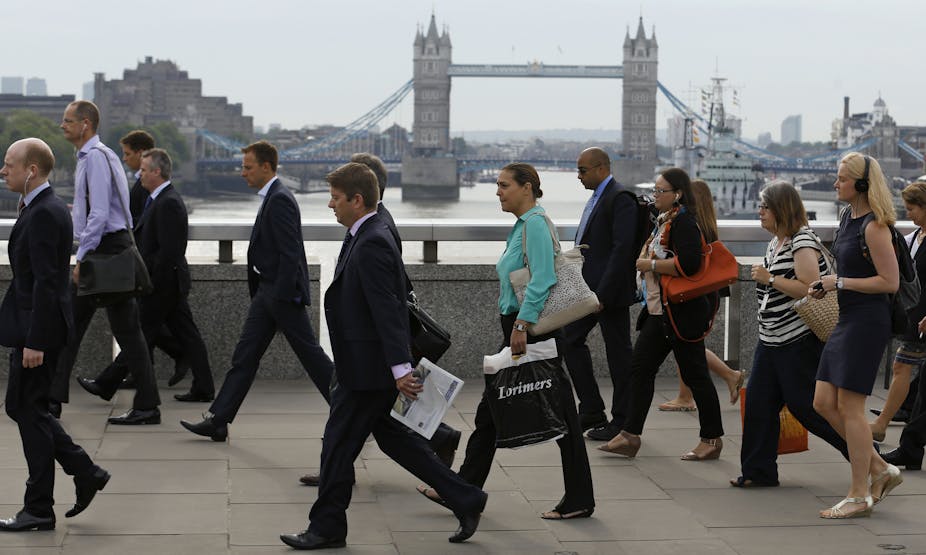We will soon get a much closer look at the gender pay gap in Britain. Around 8,000 companies with more than 250 employees will have to publish details of salaries received by men and women by 2018. But will this legislation help to close the gap?
Fellow academics, Michelle Brown and Beth Gaze, have both argued in The Conversation that greater pay transparency is an important tool to address such inequ. Frances O'Grady, general secretary of the Trades Union Congress, reckons it’s a step in the right direction. But it isn’t bold enough. Employers need to explain why the gaps exist and what they are going to do about them.
Carolyn Fairbairn, director general of the Confederation of British Industry, warned against it becoming a box-ticking exercise. She was opposed to a league table that “named and shamed” poor performers. The data will only give us a partial picture of what is happening to men and women’s pay.
Protest and survive
Why haven’t organisations done more to avoid the need for government action?
Well, it’s because they have been able to get away with it. Some women didn’t know they were being paid less. Women who have found out either put up with it or left. Some brave women successfully protested about it. The historic victory of the Dagenham car workers, and many who followed in their footsteps, resulted in the first Equal Pay Act and further legislative change.
We recently edited a Special Issue of the Cambridge Journal of Economics to evaluate the introduction of the Equal Pay Act in 1970, implemented in 1975. The gender pay gap fell most immediately after legislation took force. Despite some marked progress the impetus has stalled.
UK government analysis in 2013 showed signs of the overall gender pay gap widening. While younger women were experiencing greater equality, the gap for older women has been resistant to change. At the top of the earnings hierarchy the gap is increasing. The UK has a large wage gap compared to other EU countries according to research from the World Economic Forum and the International Labour Office (ILO).

Some spectacular equal pay cases have come before the British courts, and resulted in eye-watering compensation packages. Birmingham City Council faced a bill for back pay of £1 billion. Cambridge professor Simon Deakin and his colleagues have examined the very substantial increase in equal pay claims, such as in Birmingham, and the involvement of no-win, no-fee lawyers. They suggest that equality laws have rectified historical injustices and shouldn’t be dismissed out of hand. But increased levels of litigation have increased adversarial pay bargaining. The legal risks and costs have prompted some organisations to address the gender pay gap, but this hasn’t been without its own controversy.
Some organisations, like Cambridge University and a handful of companies, are more proactive and voluntarily publish their gender pay gap. Cambridge wants to capture and keep the best talent it can attract which includes conducting publicly available equal pay reviews to identify the gaps and what they can do about it.
Qualified success
So what are the causes of the persistent pay gap in a nutshell?
Women have become better qualified and even outnumber men at university. But these qualifications don’t always get the same recognition as men’s in terms of pay. Women’s work continues to be undervalued, even when they are at the top of their profession. Looking across sectors the average pay gap is 10%, but at the top of the hierarchy, for example among health professionals, it is over 25%.

So where does responsibility for this gap lie? A number of commentators imply that it is up to women to negotiate the best deal they can get. But most women don’t negotiate their own wages, unless they are at the very top of the hierarchy. And if they are negotiating for themselves, why would they be helping other women get a fair deal?
Australian professor Mara Olekalns argues that it is up to organisations to act to create a problem solving culture, rather than leave it up to individual women to carry the burden on their own shoulders. Negotiation is about trading labour and skills for pay and benefits, not crawling your way up to the pay already enjoyed by your peers. Do employers really want the emotional energies of their staff spent in comparing whether or not they are being paid fairly? Surely you would want them to get on with doing their jobs, proud of working in an organisation that they know treats all staff equitably?
The gender pay gap is not about women’s individual negotiating abilities. It is not about young women getting better qualifications – they are already doing that. It is, however, about what happens to women over the course of their lives and the penalties of motherhood and working part-time. In the UK there is a shortage of good quality part-time jobs, while childcare costs are the most exorbitant in Europe. Is it any wonder then that women over 40 are caught between a rock and a hard place in finding work that rewards them fairly?
Any senior manager who wants to bring about organisational change knows: if you want to move it, you have to measure it. This legislation will give us some measure of what the gaps look like. If organisations want to move it they will have to find a way. But the will to move it depends on whether or not it is a priority. If the last 45 years of equal pay legislation are anything to go by, we might expect some erratic outcomes.

